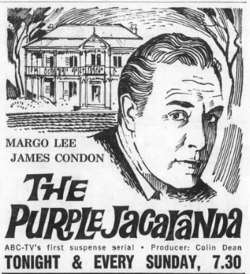The Purple Jacaranda
The Purple Jacaranda was an Australian television mini-series which aired on ABC in 1964 based on a novel by Nancy Graham. Cast included James Condon, Margo Lee, Ronald Morse, Diana Perryman, Walter Sullivan and John Unicomb.[1][2]
| The Purple Jacaranda | |
|---|---|
 Ad from SMH 28 Jun 1964 | |
| Genre | Mini-series |
| Based on | novel by Nancy Graham |
| Written by | Richard Lane |
| Country of origin | Australia |
| Original language(s) | English language |
| No. of seasons | 1 |
| Production | |
| Producer(s) | Colin Dean |
| Release | |
| Original network | Australian Broadcasting Corporation |
| First shown in | 28 June 1964 (Sydney) |
It started broadcasting in Melbourne on 12 July 1964. Desmonde Dowling did the sets.[3]
Plot
Anna James is confronted by Colonel Thomson of security who asks her to go to Sydney and stay with her friend Darcy, now married to David Crawford. David and Darcy live in Jacaranda House. Anna has misgivings but eventually agrees.
Cast
- Margo Lee as Anne James
- Diana Perryman as Darcy Crawford
- Ronald Morse as Colonel Thomson
- Walter Sullivan as David Crawford
- James Condon is artist Max Stevenson
- Nick Tate as Bill
- Camilla Christensen as Kelly
- John Unicombe as Bannister
- Aileen Britten as housekeeper
Episode Guide
- Episode One - In Perth, Anne is confronted by Colonel Thomson of Security who asks her to go to Sydney and stay with friend Darcy now married to David at Jacaranda House in Sydney
Background
Australian TV drama was relatively rare at the time.[4] In the early 1960s, ABC aired a series of historical mini-series: Stormy Petrel (1960), The Outcasts (1961), The Patriots (1962), and The Hungry Ones (1963). The Purple Jacaranda, however, featured a then-contemporary setting. It was based on a 1958 radio serial which in turn was based on a novel. Exteriors for the masnion were shot in Melbourne.[5][6]
Colin Dean said historical "serials take years of research and steeping in the period. Writers can't produce one at a moment's notice. I quite like this year's change to a modern serial, but I would be sad if we stopped doing historical serials. They are very rewarding."[7]
Reception
Unlike the historical serials, which got largely positive response by viewers and critics, The Purple Jacaranda was a critical failure.
Reviewing the pilot episode the Tribune said "It has its moments but the stiff and stagey acting and production will need to improve if it is to hold the viewer's attention."[8] The Woman's Weekly said it " didn'tcome to life in its first episode. The good part of it was producer Colin Dean's opening sequence of the body on the beach, the skilful blending of indoor and outdoor shots, and John Unicombe'sacting as Bannister; the bad parts of it were some bad flaws in the story, the general air of unreality, and the overacting of the ladies."[9]
The Canberra Times called it "the unintentionally funniest thing the A.B.C. has ever done."[10]
The Tribune later said "A completely wrong slant has been given o what is supposed to be a thriller. Every element of surpris? is telegraphed and foreshadowed. . The actors move like automatons and with about as much feeling. The dialogue which is certainly not -"ery good is made even - worse by this treatment."[11]
The Canberra Times said ", Richard Lane's script would have been funny, had not Colin Dean's direction been vulgar."[12]
The Bulletin said "Perhaps the most harshly treated is Margo Lee. In the first episode she was a young woman intelligent enough to be asked to shadow dangerous criminals. Since then she has represented simpering stupidity. Miss Lee still wears a look of pained surprise at this perfidy on the part of the scriptwriter."[13] The Weekly later called it "hideous".[14]
References
- "The Purple Jacaranda". The Canberra Times. 1 August 1964. p. 13. Retrieved 4 June 2015 – via National Library of Australia.
- "THE PURPLE JACARANDA". The Australian Women's Weekly. 15 July 1964. p. 18. Retrieved 4 June 2015 – via National Library of Australia.
- "Seven Part Mystery Challenge for ABC". The Age. 9 July 1964. p. 12.
- Vagg, Stephen (18 February 2019). "60 Australian TV Plays of the 1950s & '60s". Filmink.
- "Seven part mystery challenge for ABC". The Age. 9 July 1964. p. 12.
- ""Guarded" Suspense Serial". The Age. 20 February 1964. p. 12.
- "Life of musical genius, by Disney". The Australian Women's Weekly. 31, (42). Australia, Australia. 18 March 1964. p. 15. Retrieved 16 July 2020 – via National Library of Australia.CS1 maint: extra punctuation (link)
- "TV VIEW". Tribune (1362). New South Wales, Australia. 1 July 1964. p. 11. Retrieved 19 July 2020 – via National Library of Australia.
- "ZORRO STRIKES AGAIN". The Australian Women's Weekly. 32, ([?]). Australia, Australia. 15 July 1964. p. 19. Retrieved 19 July 2020 – via National Library of Australia.CS1 maint: extra punctuation (link)
- ""Where No Purple Jacarandas Grow"". The Canberra Times. 39, (10, 999). Australian Capital Territory, Australia. 10 November 1964. p. 17. Retrieved 19 July 2020 – via National Library of Australia.CS1 maint: extra punctuation (link)
- "BHP TVIEW". Tribune (1366). New South Wales, Australia. 29 July 1964. p. 10. Retrieved 19 July 2020 – via National Library of Australia.
- "The Critic The sound lingers on". The Canberra Times. 38, (10, 892). Australian Capital Territory, Australia. 6 July 1964. p. 12. Retrieved 19 July 2020 – via National Library of Australia.CS1 maint: extra punctuation (link)
- Rolfe, Patricia (11 August 1964). "Deep Purple". The Bulletin. p. 48.
- "The suburban history of a family". The Australian Women's Weekly. 33, (14). Australia, Australia. 1 September 1965. p. 19. Retrieved 19 July 2020 – via National Library of Australia.CS1 maint: extra punctuation (link)